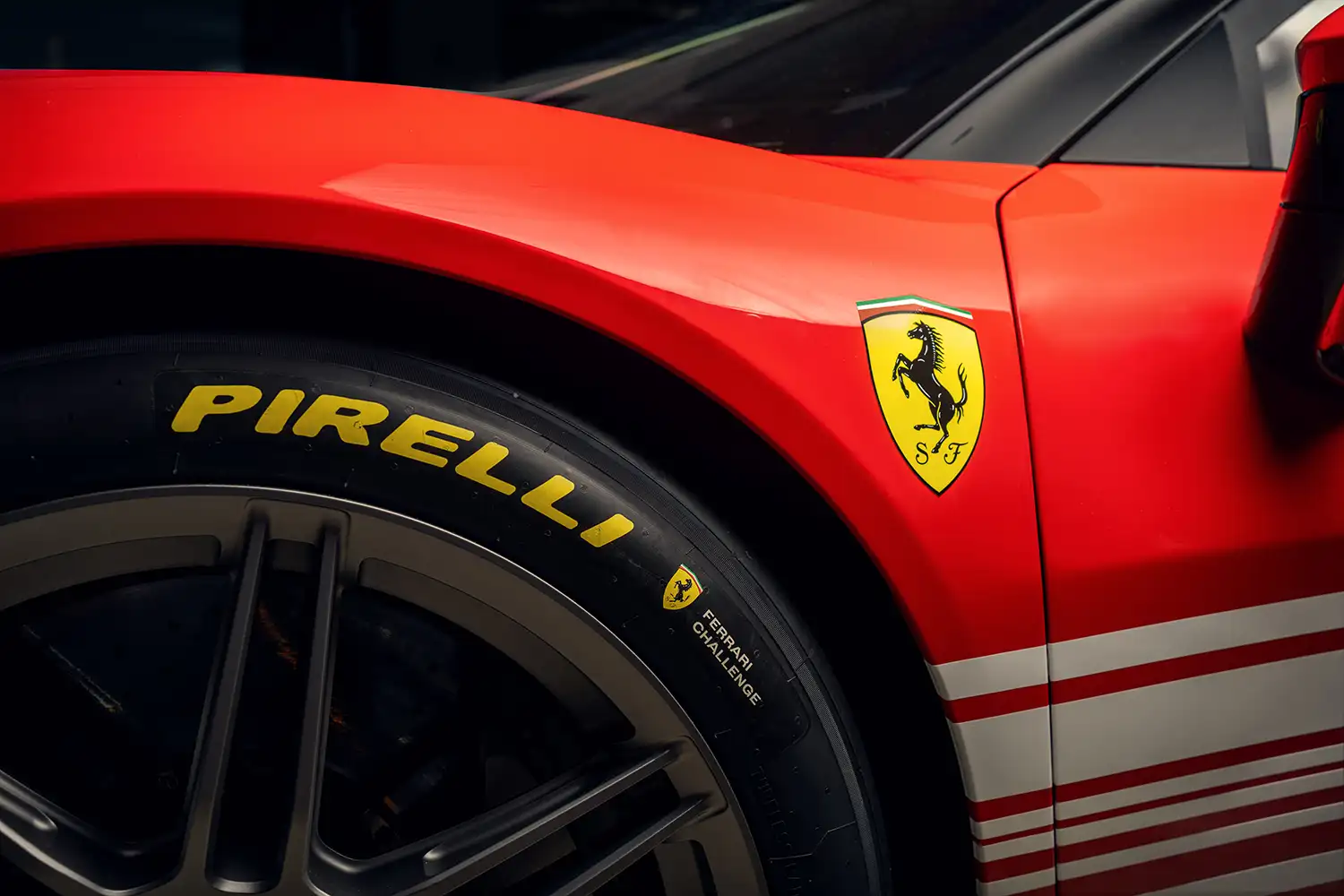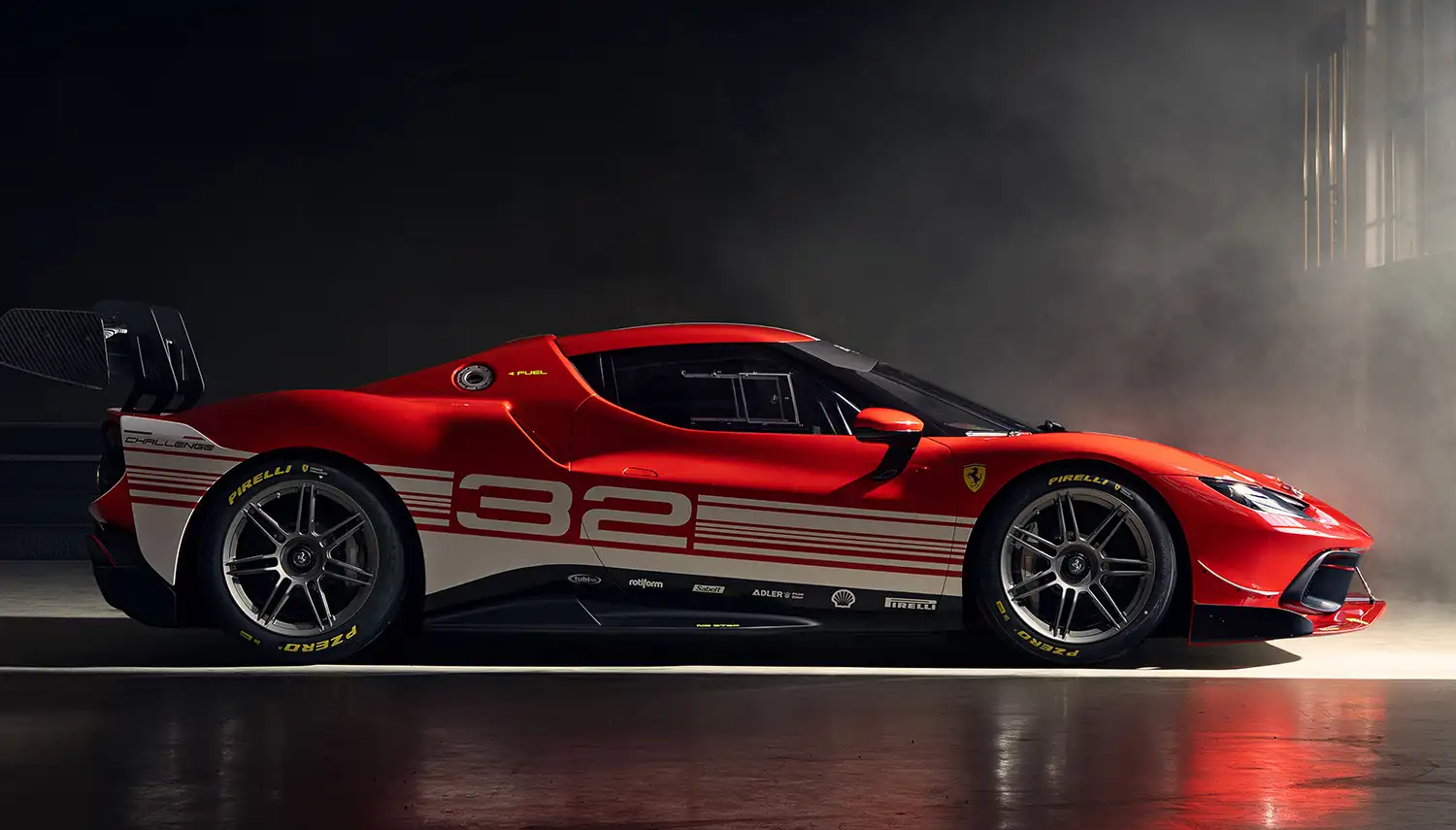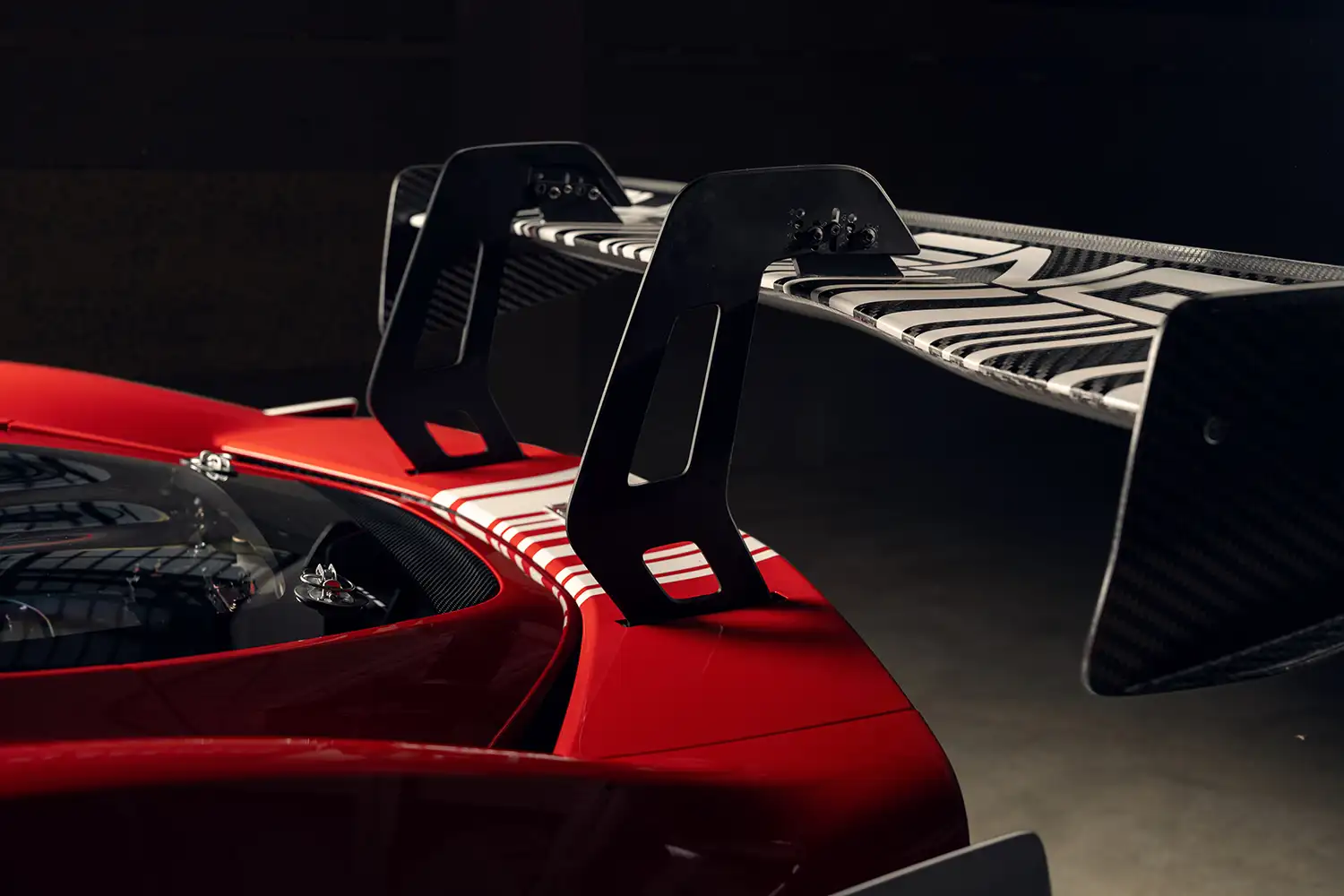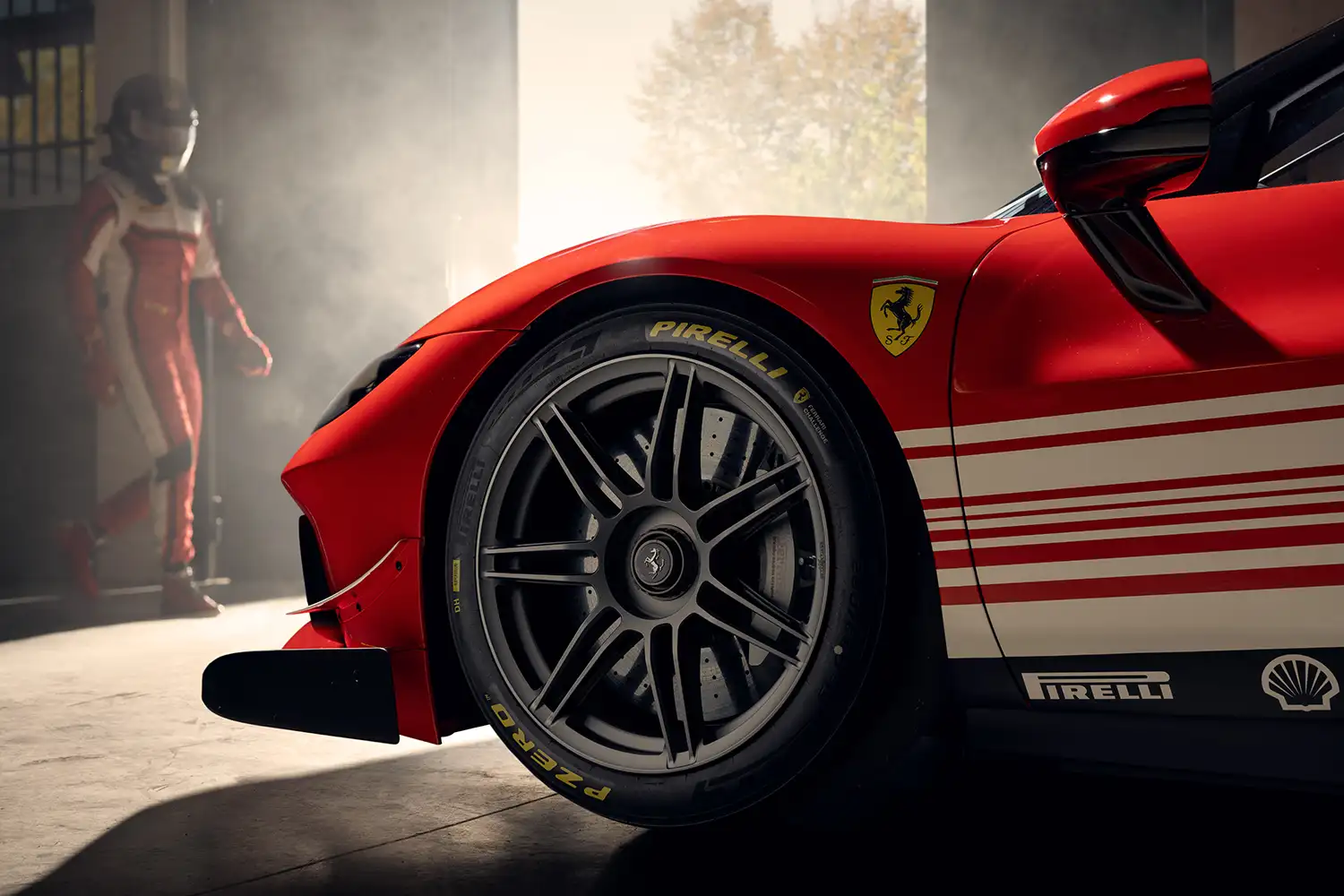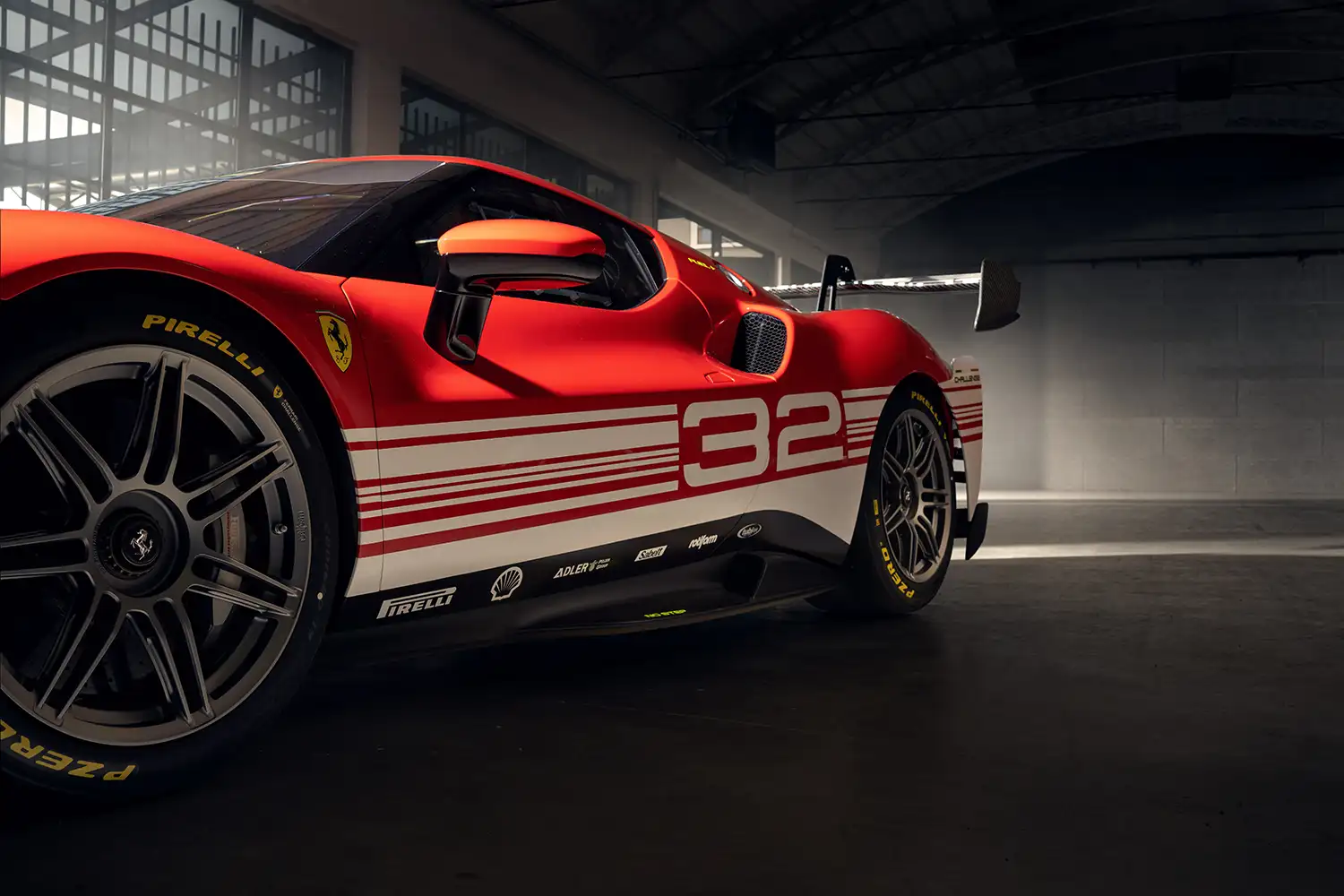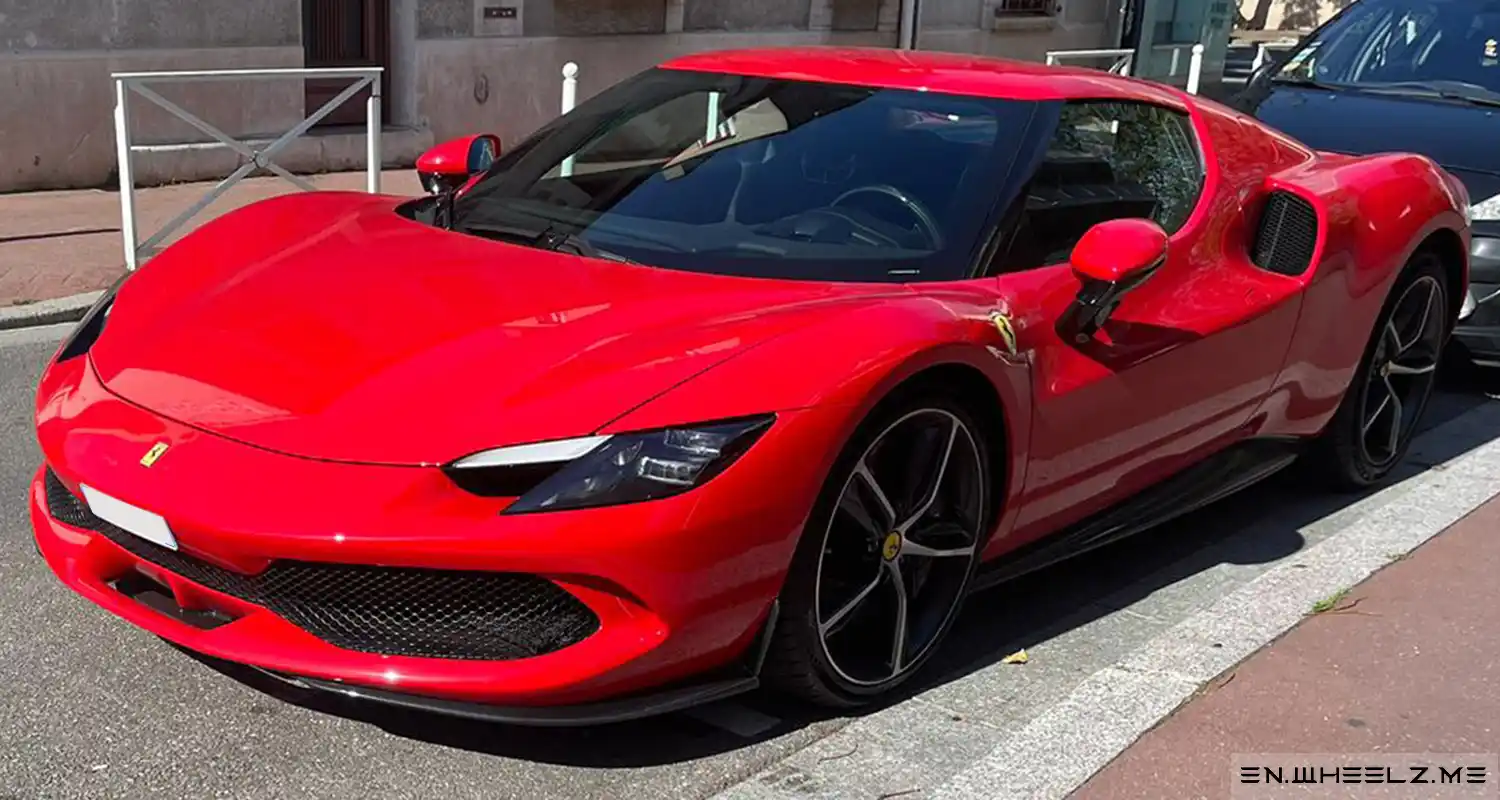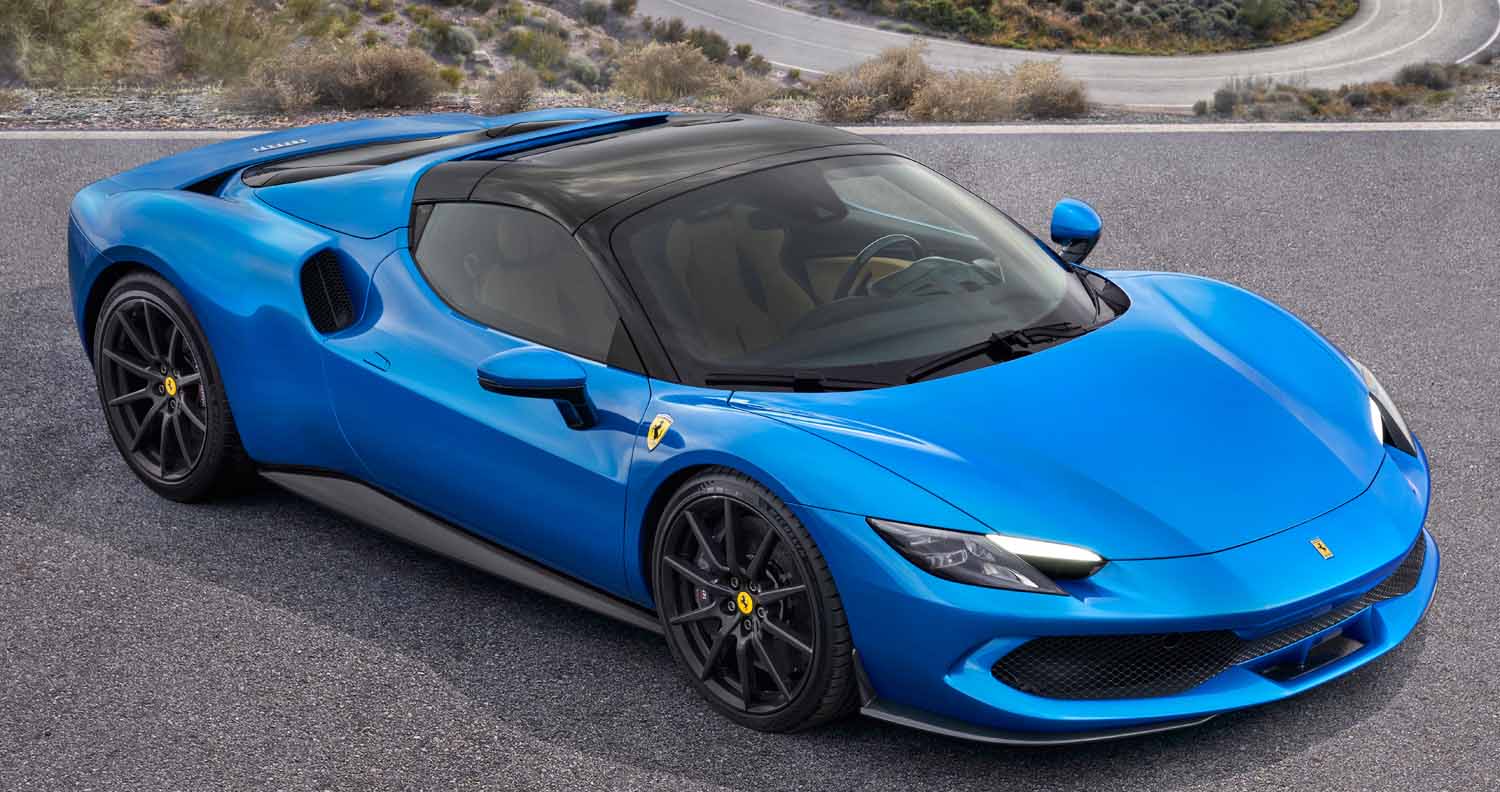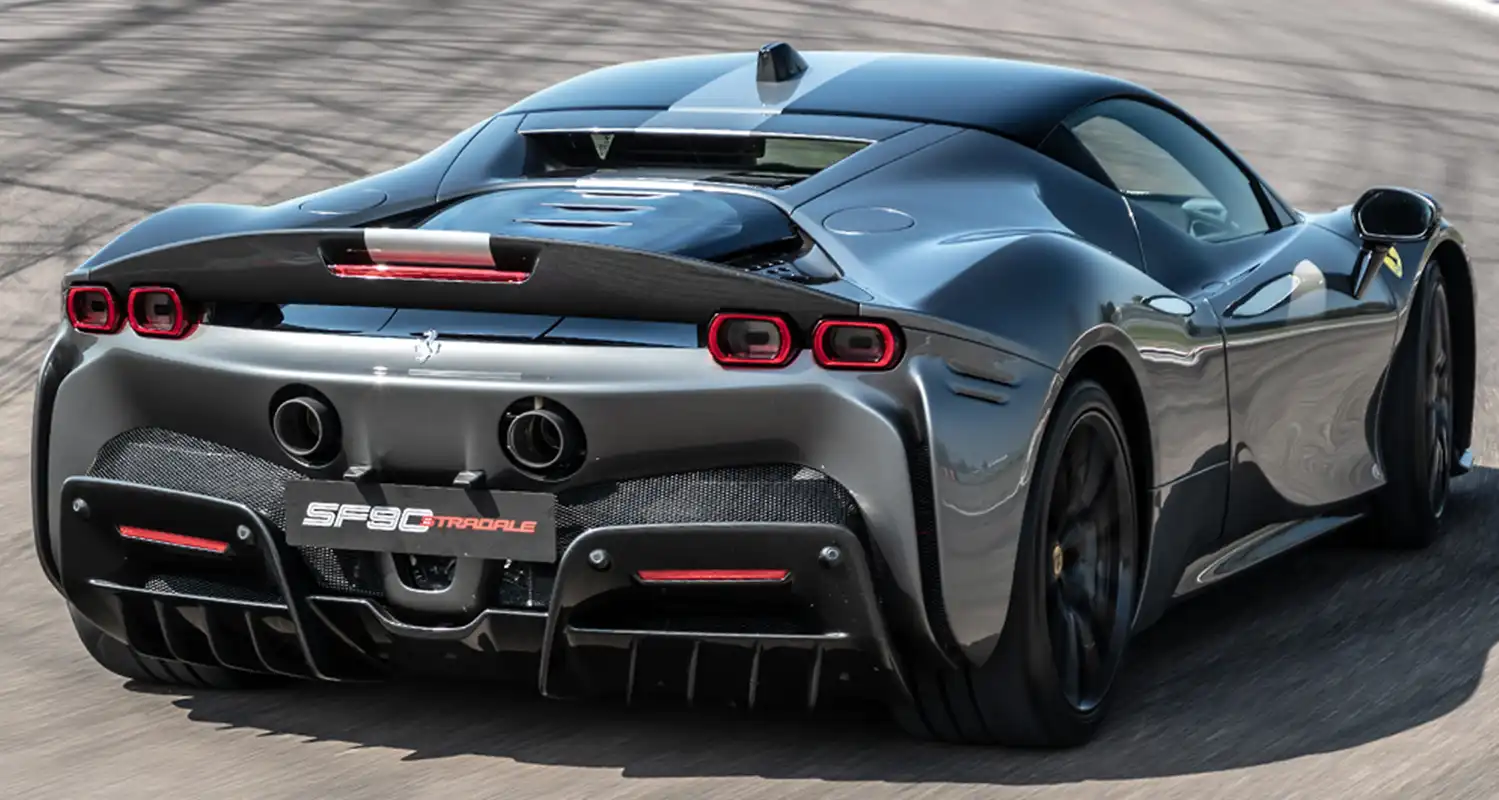
Ferrari has unveiled the 296 Challenge, which will make its debut in the 2024 season of the Ferrari Challenge, at the Mugello Circuit during the Finali Mondiali. The new car is the ninth model fielded by Ferrari in the history of its single-make championship, which is now in its 32nd season.
The car represents a tangible step forward for the company’s single-make series: the progressive improvement in quality and competitiveness of the drivers taking part worldwide meant that the 296 Challenge development team were able to make even more radical modifications to the original model than would have been the case in the past, making full use of Ferrari’s unparalleled experience in the motorsport world. Although still very much in the tradition of the cars Ferrari has developed over the years for gentlemen drivers, the 296 Challenge draws more on the experience built up with its racing counterpart, the 296 GT3, than previous models, thus also targeting drivers with ambitions for a future in GT racing.
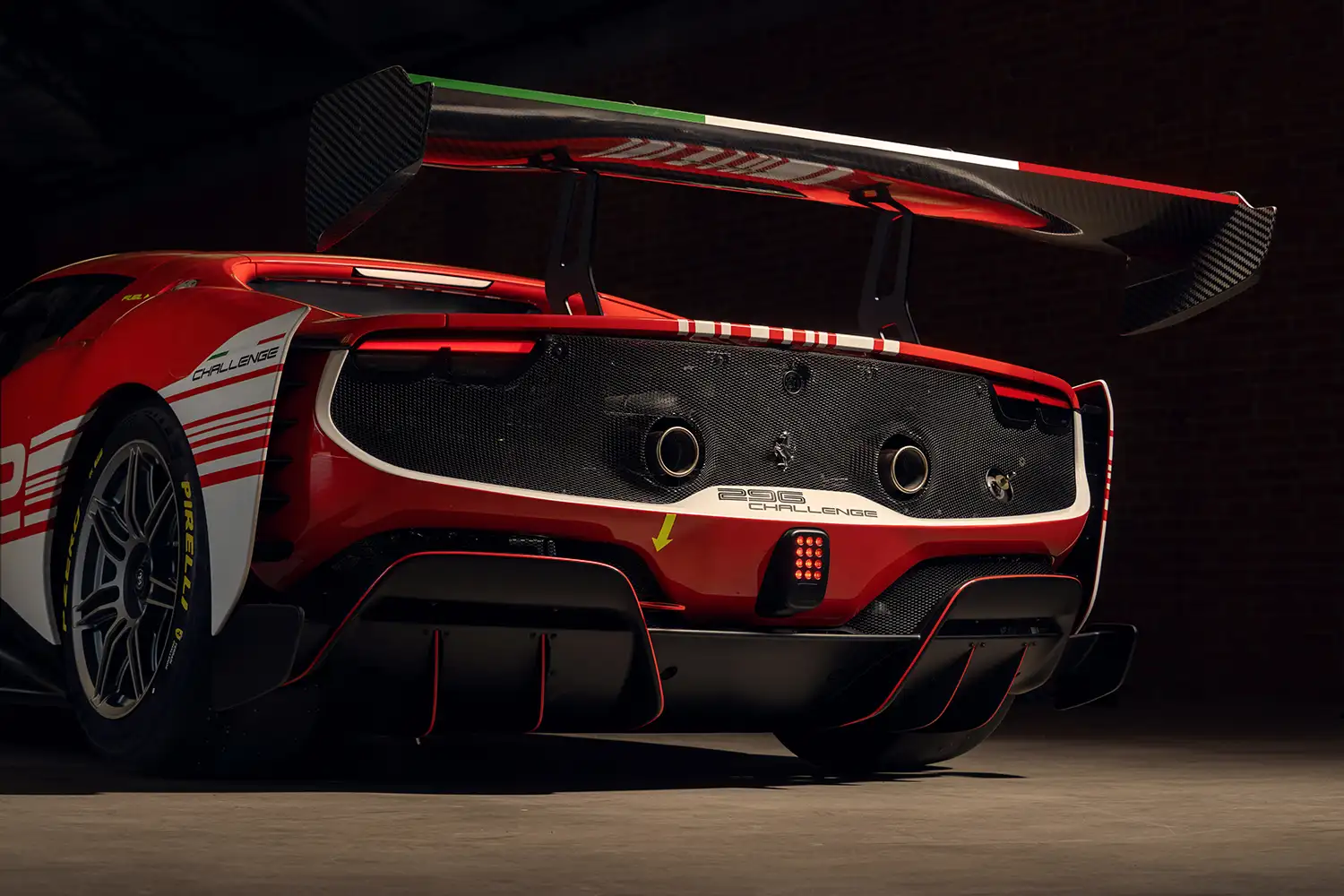
The philosophy underpinning the Ferrari 296 Challenge demanded an evolution of the concept behind the Ferrari Challenge competition model. It represents a further step on from a production-derived car with relatively modest modifications, to a car with a number of important revisions to optimise its track use. This paradigm shift allowed the design team to create a model that is, in certain respects, extreme and that significantly raises the bar in terms of overall performance, as well as in its consistency and repeatability throughout test sessions or races.
The Ferrari 296 Challenge is the very first car in the single-make series to sport a V6 engine – all of the previous models used in the series were powered by V8 engines. The biggest change over the 296 GTB, in line with the development of the 296 GT3, is that the hybrid powertrain was removed to reduce weight, while the power output was increased to 700 cv, resulting in a record specific power output for the segment – 234 cv/l. In terms of aerodynamics, the Challenge car adopts solutions derived from the 296 GT3 which have been developed to new extremes, yielding unprecedented downforce figures.
These were achieved with contributions from the S-Duct, which draws air into the central radiator and then channels it out through a vent on the bonnet, the swan-neck rear wing layout (another element that harks back to the development of the 296 GT3), and a series of devices that maximise the stability of the downforce generated in different trim conditions.

The braking system was also completely redesigned with the first-ever adoption of new CCM-R PLUS discs, which use technology derived from the most extreme track applications. The introduction of this innovation together with the circuit-specific evolution of the ABS EVO Track used on the 296 GTB, has delivered previously unimaginable braking performance and repeatability. New Pirelli tyres specifically developed for the model also contribute to this achievement. The 296 Challenge is 2″ faster around Mugello than the previous model, the 488 Challenge Evo, which was presented at the 2019 Finali Mondiali at Mugello and debuted in the 2020 season. Significantly, the 296 Challenge can also deliver that performance consistently throughout an entire race.
POWERTRAIN
At the very start of the development process, it was decided to remove the hybrid elements from the V6 powertrain as per the 296 GT3. The electric motor and high voltage battery were eliminated and power output of the twin-turbo V6 was boosted to 700 cv. This approach helped limit the car’s weight and the complexity of the overall unit, both fundamental factors for track applications.
The new architecture led to the development of a more linear exhaust line located in the upper part of the engine compartment. The shape of the exhaust reduces back pressure by 30% and provides a significant contribution to the increase in power. The Gasoline Particulate Filter (GPF) used on the road car has been removed, but the highly permeable catalytic converter normally used in racing remains.

Compared to the road-going engine, the Challenge specification sees a number of modifications to capitalise on the lower back pressure. The maximum speed of the turbos has been increased by 10% to 180,000 rpm, increasing the turbo boost pressure by the same amount, and the spark advance has been anticipated, providing a slight increase in pressure in the combustion chamber. The result is a 37 cv increase in power compared to the road-going 296 GTB and GTS, with the same maximum torque output, slightly lower in the rev range.
The increase in the V6’s power output required additional thermal protection in the engine bay with specific turbo insulation. Removing the hybrid elements also led to the introduction of an air-con compressor and a 12-volt starter motor, both driven by the crankshaft via a dedicated belt, fulfilling the dual function of starting the engine and charging the 12V electrical system.
Thanks to its new 234 cv/l specific power output, the Ferrari 296 Challenge’s ICE sets a new record for a road-derived Ferrari and demonstrates just how central technology transfer – from road to race, and race to road – is to Ferrari in order to constantly develop its products.

VEHICLE DYNAMICS
The 296 Challenge’s braking system sets a new benchmark thanks to the world-first adoption of CCM-R PLUS for the brake discs (408mm diameter at the front, 390 mm at the back). This solution is derived directly from the most extreme applications in motorsport, not least Formula 1, and exceeds the performance of all other carbon-ceramic brakes used in racing.
The manufacturing technology uses long carbon fibres in a 3D, multi-directional matrix to deliver a tangible increase in durability (+ 100%) and thermal conductivity (a three-times improvement) compared to a traditional CCM solution. The braking surface also has a special silicon carbide (SiC) ceramic coating which improves durability and delivers an excellent coefficient of friction in the most extreme conditions of use.
Disc cooling is by way of a complex layout of ventilation ducts, employing cutting-edge CFD computation techniques to optimise their geometry. The lifespan of the CCM-R PLUS disc is around three times that of the CCM version, with no tapering of performance whatsoever across its entire lifespan.

The ABS EVO brake-by-wire control system, introduced for the first time on the 296 GTB, has been evolved specifically for track use on the Ferrari 296 Challenge. This new controller uses the information from the 6-way Chassis Dynamic Sensor (6w-CDS) to obtain a very precise estimation of speed and thus determine the target slip for all four wheels and optimise braking distribution. This in turn allows the longitudinal force of the tyres to be better exploited when braking in a straight line and on braking on turn-in (with an average 6% improvement at the rear alone), when the rear axle is subject to the natural compromise between braking performance and lateral stability.
At the same time, more accurate estimation allows repeatability of the manoeuvre around the target value to be maximised, reducing variations due to the tolerances of the components or the natural variability of test conditions, such as tarmac temperature. The combination of the ABS EVO Track and the innovative CCM-R PLUS discs means the 296 Challenge delivers previously unthinkable performance in terms of both average deceleration and repeatability in extreme use, thus enhancing the car’s performance on the track.
The Ferrari 296 Challenge is equipped with new Pirelli tyres, with a design phase that involved the use of advanced simulation technologies and almost a year of development, including a variety of different verification loops on international circuits. The use of a wider front wheel with an 11″ channel allowed Pirelli to develop a tyre geared towards better turn-in grip, lower wear and greater consistency over the course of a race.
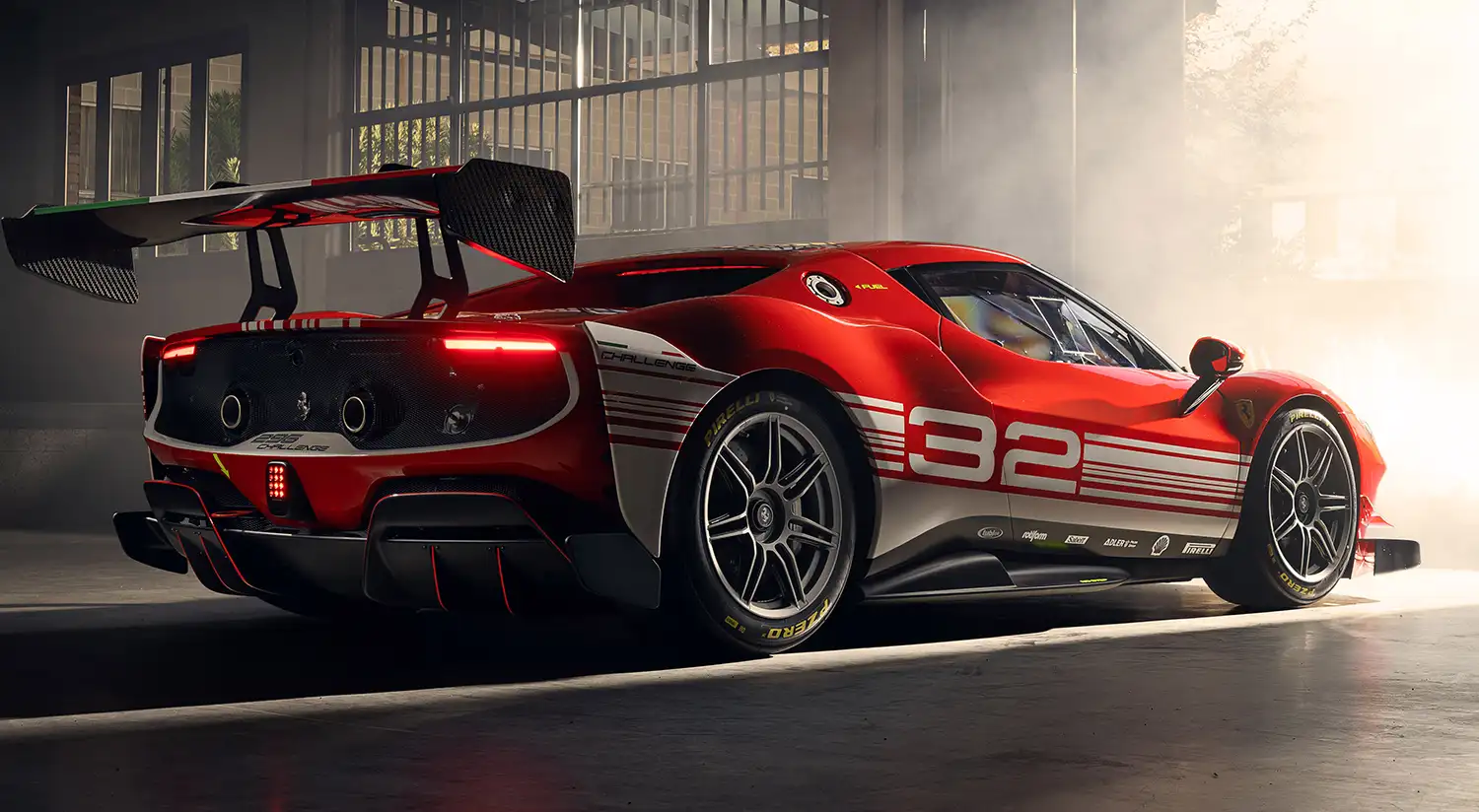
AERODYNAMICS
The aim with the Ferrari 296 Challenge’s aero development was to use the knowledge built up with the 296 GT3, to deliver unprecedented downforce figures for Ferrari’s single-make series. The primary goal of delivering downforce that is easily exploitable on the track was achieved by keeping variations and balance to an absolute minimum both on the straight and through corners. This makes the car agile and responsive and very predictable at high speeds, thereby simultaneously guaranteeing extreme performance and driving thrills.
The layout of the cooling system was modified as a result of removing the hybrid elements. The location and arrangement of the radiating masses is the same as on the 296 GT3, with the water radiator for the high temperature circuit at the front, with the condenser for HVAC circuit ahead of it. The two intercoolers and the engine air filters from its road-going counterpart have been retained at the rear.
At the front, the engine coolant radiator is fed by an air intake in the centre of the bumper: this allows the maximum possible amount of cold air to be drawn in in dynamic conditions. The hot air coming off the radiator is drawn upwards and exits through a vent on the front bonnet. This GT3-derived solution increases the amount of cooling air and seals the car’s underbody, a fundamental area in high-efficiency downforce generation.

The vent on the bonnet has specific wing profiles that optimise the venting of the air from the S-Duct channel, which is immediately behind the radiator shroud. The rear bumper has been redesigned compared to the 296 GTB: the engine bay venting area is now much larger to guarantee adequate extraction of hot air flows in both static and dynamic conditions.
Huge work was lavished on honing the fluid-dynamics of the brake ventilation ducts. At the front, the air intakes are on either side of the coolant radiator, while at the rear, cooling demands required separate ducts. Part of the air flow is drawn in through an intake on the sill, while a second air flow is directed through an aperture in the rear bodywork, just ahead of the fixed wing.
The Ferrari 296 Challenge can generate 870 kg of downforce at 250 km/h with the spoiler at its maximum angle of attack. This is an 18% increase in downforce compared to the 488 Challenge Evo. The car’s aero design focused not just on the pursuit of performance, but also on driveability. To achieve both of these goals, the car’s sensitivity to variations in downforce and the aero balance to the car’s ground clearance, yaw and roll were minimized
 .
.
Most of downforce over the front axle is generated by the splitters and the front section of the underbody, while the rear aero is dominated by the adjustable-angle fixed wing. The front underbody was designed to create ground effect to keep the flow stable even when the ride is reduced under braking or in cornering. The central area is dominated by the S-Duct, which connects the underbody with the upper body to maximise the efficiency of the central diffuser and tangibly reduce the sensitivity of the 296 Challenge’s aero balance to pitch. Aside from acting as a vent for the air feeding the central diffuser, the S-Duct creates a connection between the underbody, which functions in close proximity to the ground, and the upper body, an area in which pressure remains much more consistent in racing conditions.
The underbody in the central area has been raised: having it higher off the ground guarantees that the central diffuser can work efficiently during manoeuvres when the front of the car is closer to the ground, such as, for instance, braking at the end of a straight, thereby guaranteeing much more consistent downforce.
There are two diffuser ramps, one on either side of the S-Duct, which create vertical expansion. Either end of the splitter, below the flick, is a separate wing section, which marks the debut on a closed-wheel competition car of the F1-inspired, double-element concept that makes downforce less sensitive to variations in trim.

Behind the S-Duct are three pairs of vortex generators, which create vortices on the underbody and generate lateral expansion, creating local suction and consequently high-efficiency downforce. The side of the splitter was designed to activate the underbody and manage the flows downstream of it. The end plates generate concentrated vortices to manage the wake from the front wheels.
Downforce generation over the rear axle comes mostly from the fixed spoiler, the angle of which can be adjusted to seven different positions. This allows the downforce level and balance to be set to meet the specific requirements of each circuit the car competes on. The wing is supported by two aerofoil struts, which attach on the upper surface. This solution minimises aerodynamic interference on the underside of the profile, which generates most of the downforce and is more sensitive to flow disruption.
The wing’s end plates are equipped with appendages that generate downforce and improve the efficiency of the lower edge of the profile. The wing works in symbiosis with the rear diffuser and the underbody, which has two pairs of vortex generators in its rear section.
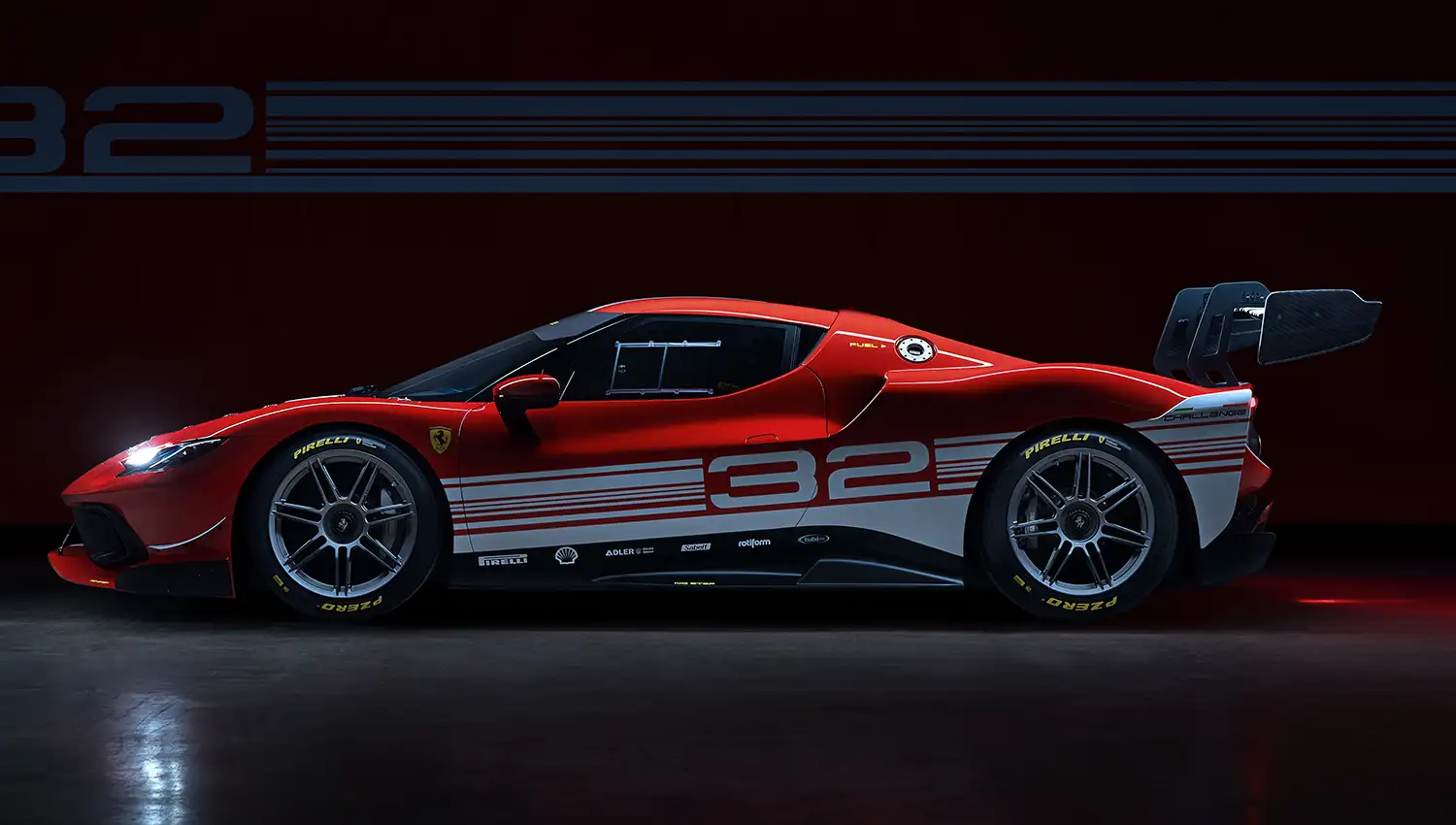
The rear bumper has also been redesigned with respect to the 296 GTB: the vertical exterior profile has been optimised to reduce drag. Two vents have been added at the sides to channel air out of the rear wheel arches and into the car’s wake. This optimises the efficiency of the rear underbody and reduces overall drag, thereby boosting overall aero efficiency.
COCKPIT AND SAFETY
The Ferrari 296 Challenge’s cockpit benefits from Ferrari’s experience in both the single-make series and GT racing. The ergonomic Ferrari 488 Challenge Evo steering wheel design has been retained with ad hoc improvements. Amongst the main differences is the position of the engine rev LED bar which is no longer on the steering wheel, but in the digital instrument display, making it more readable. The cockpit has been updated with a new control layout on the central tunnel, designed to ensure that the most frequently used controls are always to hand.
The circular air con vents deliver an optimal flow to improve driver comfort and can be adjusted in all directions, while the seat, which is derived from the 296 GT3, was developed to further improve ergonomics, particularly in the head, shoulder and elbow areas. In compliance with the international FIA racing standards, the roll cage has been meticulously designed down to the last detail, using the most sophisticated computation technologies.
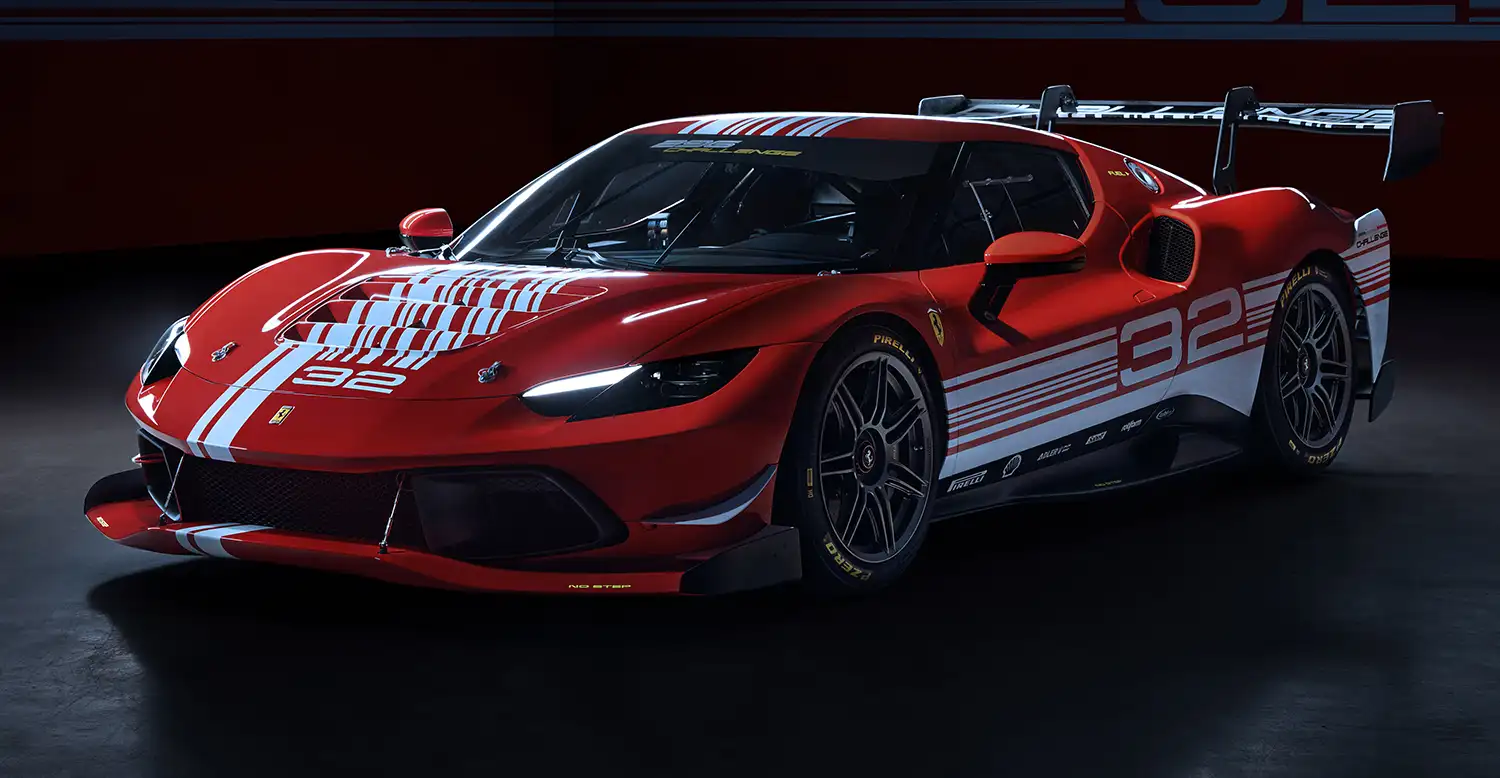
OPTIONAL EQUIPMENT
A passenger seat can be installed if the driver wants support on the track from a coach or to treat a guest to the thrill of a lap aboard the 296 Challenge. The passenger seat can be easily removed to return the car to racing spec.
LTE ANTENNA
The LTE antenna provides a Marshalling function (communications from the race marshals sent directly to the instrument panel) and will be compulsory for cars competing in the Challenge championship. Further functions may be added successively.
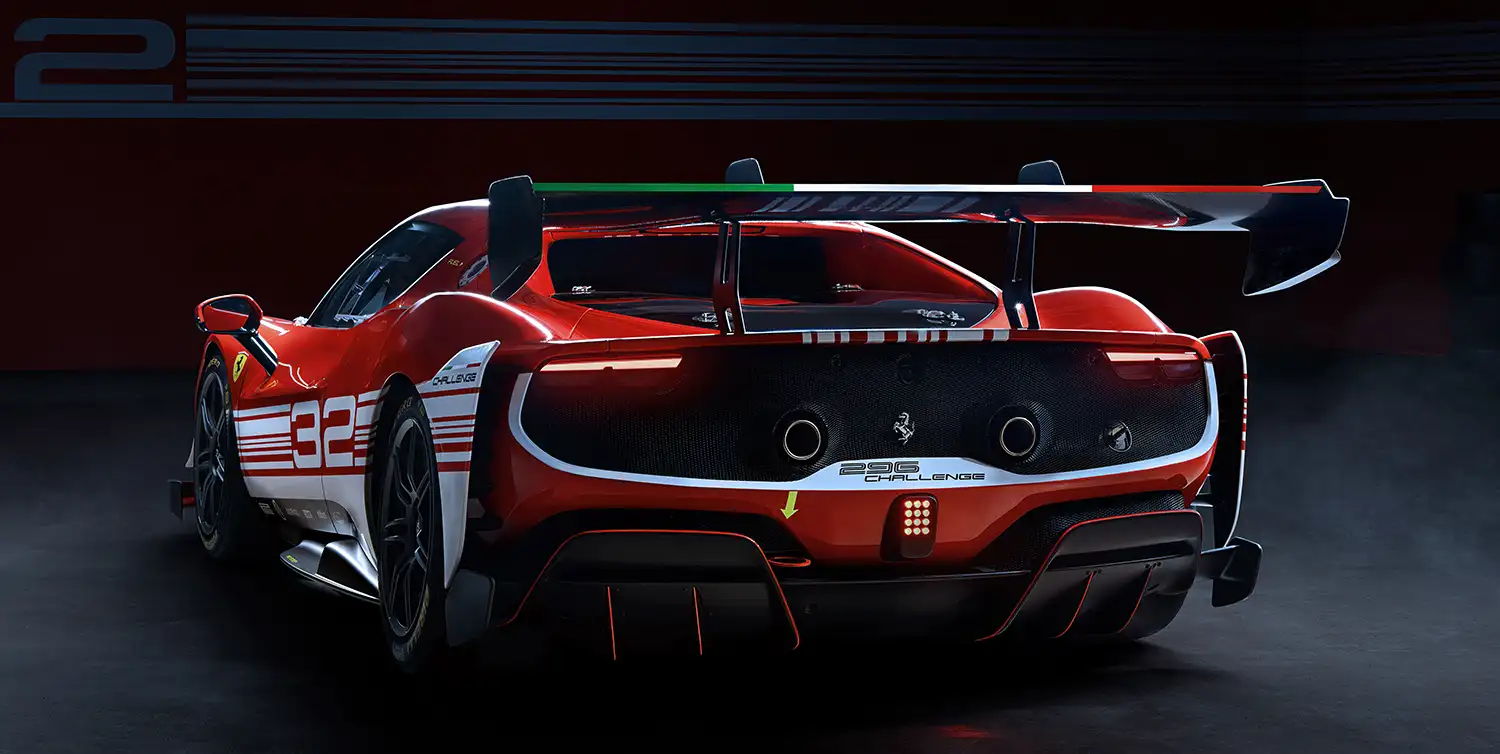
EXHAUST SILENCERS
For tracks with noise level restrictions, Ferrari has developed a specific silencer that can easily be fitted to the basic exhaust line by removing the two tail pipes.
FERRARI CHALLENGE
The 296 Challenge will make its first appearance in the 2024 season as the protagonist in the Europe and North America series of the Ferrari Challenge Trofeo Pirelli; it will make its debut in the UK and Japan series the following season.

The Ferrari 296 Challenge is the ninth model to be launched in the history of the Prancing Horse’s single-make series, the first edition of which was organised in 1993. Now the longest-running single-make championship on the international scene, it has seen the following models being fielded: 348 Challenge (1993-95), F355 Challenge (1995-2001), 360 Challenge (2000-2006), F430 Challenge (2006-2011), 458 Challenge (2011-2013), 458 Challenge Evo (2014-17), 488 Challenge (2017-2019) and the 488 Challenge Evo (2020-).
TECHNICAL SPECIFICATIONS
- ENGINE
- Type: V6 – 120° – turbo – dry sump
- Overall displacement: 2992 cc
- Bore and stroke: 88 mm x 82 mm
- Max. power output: 700 cv @ 7500 rpm
- Max. torque: 740 Nm @ 6000 rpm
- Specific power output: 234 cv/l
- Max. revs: 8500 rpm
- Compression ratio: 9.4 : 1
- DIMENSIONS AND WEIGHTS
- Length: 4602 mm (4851 mm including rear wing overhang)
- Width: 1958 mm
- Height: 1159 mm (1231 mm including rear wing overhang)
- Wheelbase: 2600 mm
- Front track: 1715 mm
- Rear track: 1647 mm
- Dry weight: 1330 kg
- Tank capacity: 140 l
- TYRES AND WHEELS
- Front: 280/680 ZR19 J11
- Rear: 300/720 ZR19 J12
- BRAKES
- Front disc: 408 x 233 x 38 mm
- Rear disc: 390 x 265 x 32 mm
- TRANSMISSION AND GEARBOX
- 7-speed F1 DCT
- ELECTRONIC CONTROLS
- TC/e-Diff, EPS, ABS EVO/EBD
